Andrew Zhao
Are My Optimized Prompts Compromised? Exploring Vulnerabilities of LLM-based Optimizers
Oct 16, 2025Abstract:Large language model (LLM) systems now underpin everyday AI applications such as chatbots, computer-use assistants, and autonomous robots, where performance often depends on carefully designed prompts. LLM-based prompt optimizers reduce that effort by iteratively refining prompts from scored feedback, yet the security of this optimization stage remains underexamined. We present the first systematic analysis of poisoning risks in LLM-based prompt optimization. Using HarmBench, we find systems are substantially more vulnerable to manipulated feedback than to injected queries: feedback-based attacks raise attack success rate (ASR) by up to $\Delta$ASR = 0.48. We introduce a simple fake-reward attack that requires no access to the reward model and significantly increases vulnerability, and we propose a lightweight highlighting defense that reduces the fake-reward $\Delta$ASR from 0.23 to 0.07 without degrading utility. These results establish prompt optimization pipelines as a first-class attack surface and motivate stronger safeguards for feedback channels and optimization frameworks.
Emulating Human-like Adaptive Vision for Efficient and Flexible Machine Visual Perception
Sep 18, 2025Abstract:Human vision is highly adaptive, efficiently sampling intricate environments by sequentially fixating on task-relevant regions. In contrast, prevailing machine vision models passively process entire scenes at once, resulting in excessive resource demands scaling with spatial-temporal input resolution and model size, yielding critical limitations impeding both future advancements and real-world application. Here we introduce AdaptiveNN, a general framework aiming to drive a paradigm shift from 'passive' to 'active, adaptive' vision models. AdaptiveNN formulates visual perception as a coarse-to-fine sequential decision-making process, progressively identifying and attending to regions pertinent to the task, incrementally combining information across fixations, and actively concluding observation when sufficient. We establish a theory integrating representation learning with self-rewarding reinforcement learning, enabling end-to-end training of the non-differentiable AdaptiveNN without additional supervision on fixation locations. We assess AdaptiveNN on 17 benchmarks spanning 9 tasks, including large-scale visual recognition, fine-grained discrimination, visual search, processing images from real driving and medical scenarios, language-driven embodied AI, and side-by-side comparisons with humans. AdaptiveNN achieves up to 28x inference cost reduction without sacrificing accuracy, flexibly adapts to varying task demands and resource budgets without retraining, and provides enhanced interpretability via its fixation patterns, demonstrating a promising avenue toward efficient, flexible, and interpretable computer vision. Furthermore, AdaptiveNN exhibits closely human-like perceptual behaviors in many cases, revealing its potential as a valuable tool for investigating visual cognition. Code is available at https://github.com/LeapLabTHU/AdaptiveNN.
MorphEUS: Morphable Omnidirectional Unmanned System
May 23, 2025Abstract:Omnidirectional aerial vehicles (OMAVs) have opened up a wide range of possibilities for inspection, navigation, and manipulation applications using drones. In this paper, we introduce MorphEUS, a morphable co-axial quadrotor that can control position and orientation independently with high efficiency. It uses a paired servo motor mechanism for each rotor arm, capable of pointing the vectored-thrust in any arbitrary direction. As compared to the \textit{state-of-the-art} OMAVs, we achieve higher and more uniform force/torque reachability with a smaller footprint and minimum thrust cancellations. The overactuated nature of the system also results in resiliency to rotor or servo-motor failures. The capabilities of this quadrotor are particularly well-suited for contact-based infrastructure inspection and close-proximity imaging of complex geometries. In the accompanying control pipeline, we present theoretical results for full controllability, almost-everywhere exponential stability, and thrust-energy optimality. We evaluate our design and controller on high-fidelity simulations showcasing the trajectory-tracking capabilities of the vehicle during various tasks. Supplementary details and experimental videos are available on the project webpage.
Absolute Zero: Reinforced Self-play Reasoning with Zero Data
May 07, 2025Abstract:Reinforcement learning with verifiable rewards (RLVR) has shown promise in enhancing the reasoning capabilities of large language models by learning directly from outcome-based rewards. Recent RLVR works that operate under the zero setting avoid supervision in labeling the reasoning process, but still depend on manually curated collections of questions and answers for training. The scarcity of high-quality, human-produced examples raises concerns about the long-term scalability of relying on human supervision, a challenge already evident in the domain of language model pretraining. Furthermore, in a hypothetical future where AI surpasses human intelligence, tasks provided by humans may offer limited learning potential for a superintelligent system. To address these concerns, we propose a new RLVR paradigm called Absolute Zero, in which a single model learns to propose tasks that maximize its own learning progress and improves reasoning by solving them, without relying on any external data. Under this paradigm, we introduce the Absolute Zero Reasoner (AZR), a system that self-evolves its training curriculum and reasoning ability by using a code executor to both validate proposed code reasoning tasks and verify answers, serving as an unified source of verifiable reward to guide open-ended yet grounded learning. Despite being trained entirely without external data, AZR achieves overall SOTA performance on coding and mathematical reasoning tasks, outperforming existing zero-setting models that rely on tens of thousands of in-domain human-curated examples. Furthermore, we demonstrate that AZR can be effectively applied across different model scales and is compatible with various model classes.
Does Reinforcement Learning Really Incentivize Reasoning Capacity in LLMs Beyond the Base Model?
Apr 18, 2025Abstract:Reinforcement Learning with Verifiable Rewards (RLVR) has recently demonstrated notable success in enhancing the reasoning capabilities of LLMs, particularly in mathematics and programming tasks. It is widely believed that RLVR enables LLMs to continuously self-improve, thus acquiring novel reasoning abilities that exceed corresponding base models' capacity. In this study, however, we critically re-examines this assumption by measuring the pass@\textit{k} metric with large values of \textit{k} to explore the reasoning capability boundary of the models across a wide range of model families and benchmarks. Surprisingly, the RL does \emph{not}, in fact, elicit fundamentally new reasoning patterns. While RL-trained models outperform their base models at smaller values of $k$ (\eg, $k$=1), base models can achieve a comparable or even higher pass@$k$ score compared to their RL counterparts at large $k$ values. The reasoning paths generated by RL-trained models are already included in the base models' sampling distribution, suggesting that most reasoning abilities manifested in RL-trained models are already obtained by base models. Further analysis shows that RL training boosts the performance by biasing the model's output distribution toward paths that are more likely to yield rewards, therefore sampling correct responses more efficiently. But this also results in a narrower reasoning capability boundary compared to base models. Similar results are observed in visual reasoning tasks trained with RLVR. Moreover, we find that distillation can genuinely introduce new knowledge into the model, different from RLVR. These findings underscore a critical limitation of RLVR in advancing LLM reasoning abilities which requires us to fundamentally rethink the impact of RL training in reasoning LLMs and the need of a better paradigm. Project Page: https://limit-of-RLVR.github.io
Optimizing Social Media Annotation of HPV Vaccine Skepticism and Misinformation Using Large Language Models: An Experimental Evaluation of In-Context Learning and Fine-Tuning Stance Detection Across Multiple Models
Nov 22, 2024


Abstract:This paper leverages large-language models (LLMs) to experimentally determine optimal strategies for scaling up social media content annotation for stance detection on HPV vaccine-related tweets. We examine both conventional fine-tuning and emergent in-context learning methods, systematically varying strategies of prompt engineering across widely used LLMs and their variants (e.g., GPT4, Mistral, and Llama3, etc.). Specifically, we varied prompt template design, shot sampling methods, and shot quantity to detect stance on HPV vaccination. Our findings reveal that 1) in general, in-context learning outperforms fine-tuning in stance detection for HPV vaccine social media content; 2) increasing shot quantity does not necessarily enhance performance across models; and 3) different LLMs and their variants present differing sensitivity to in-context learning conditions. We uncovered that the optimal in-context learning configuration for stance detection on HPV vaccine tweets involves six stratified shots paired with detailed contextual prompts. This study highlights the potential and provides an applicable approach for applying LLMs to research on social media stance and skepticism detection.
Learning the structure of any Hamiltonian from minimal assumptions
Oct 29, 2024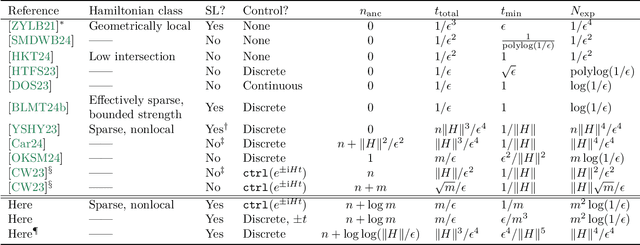
Abstract:We study the problem of learning an unknown quantum many-body Hamiltonian $H$ from black-box queries to its time evolution $e^{-\mathrm{i} H t}$. Prior proposals for solving this task either impose some assumptions on $H$, such as its interaction structure or locality, or otherwise use an exponential amount of computational postprocessing. In this paper, we present efficient algorithms to learn any $n$-qubit Hamiltonian, assuming only a bound on the number of Hamiltonian terms, $m \leq \mathrm{poly}(n)$. Our algorithms do not need to know the terms in advance, nor are they restricted to local interactions. We consider two models of control over the time evolution: the first has access to time reversal ($t < 0$), enabling an algorithm that outputs an $\epsilon$-accurate classical description of $H$ after querying its dynamics for a total of $\widetilde{O}(m/\epsilon)$ evolution time. The second access model is more conventional, allowing only forward-time evolutions; our algorithm requires $\widetilde{O}(\|H\|^3/\epsilon^4)$ evolution time in this setting. Central to our results is the recently introduced concept of a pseudo-Choi state of $H$. We extend the utility of this learning resource by showing how to use it to learn the Fourier spectrum of $H$, how to achieve nearly Heisenberg-limited scaling with it, and how to prepare it even under our more restricted access models.
LLM-based Optimization of Compound AI Systems: A Survey
Oct 21, 2024

Abstract:In a compound AI system, components such as an LLM call, a retriever, a code interpreter, or tools are interconnected. The system's behavior is primarily driven by parameters such as instructions or tool definitions. Recent advancements enable end-to-end optimization of these parameters using an LLM. Notably, leveraging an LLM as an optimizer is particularly efficient because it avoids gradient computation and can generate complex code and instructions. This paper presents a survey of the principles and emerging trends in LLM-based optimization of compound AI systems. It covers archetypes of compound AI systems, approaches to LLM-based end-to-end optimization, and insights into future directions and broader impacts. Importantly, this survey uses concepts from program analysis to provide a unified view of how an LLM optimizer is prompted to optimize a compound AI system. The exhaustive list of paper is provided at https://github.com/linyuhongg/LLM-based-Optimization-of-Compound-AI-Systems.
Model Surgery: Modulating LLM's Behavior Via Simple Parameter Editing
Jul 11, 2024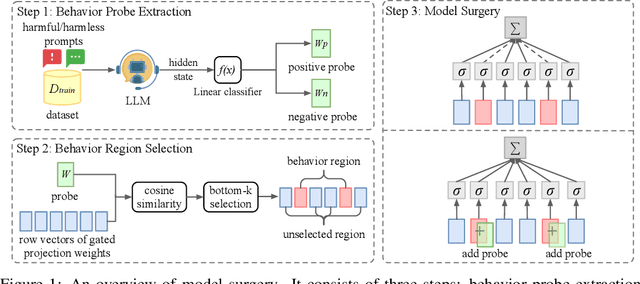


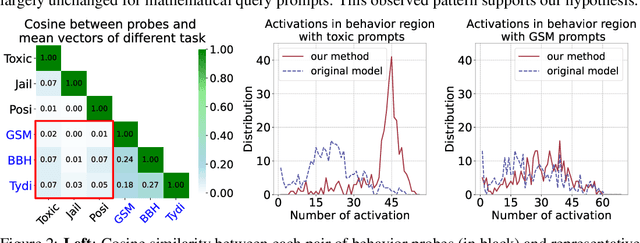
Abstract:Large Language Models (LLMs) have demonstrated great potential as generalist assistants, showcasing powerful task understanding and problem-solving capabilities. To deploy LLMs as AI assistants, it is crucial that these models exhibit desirable behavioral traits, such as non-toxicity and resilience against jailbreak attempts. Current methods for detoxification or preventing jailbreaking usually involve Supervised Fine-Tuning (SFT) or Reinforcement Learning from Human Feedback (RLHF), which requires finetuning billions of parameters through gradient descent with substantial computation cost. Furthermore, models modified through SFT and RLHF may deviate from the pretrained models, potentially leading to a degradation in foundational LLM capabilities. In this paper, we observe that surprisingly, directly editing a small subset of parameters can effectively modulate specific behaviors of LLMs, such as detoxification and resistance to jailbreaking. Specifically, for a behavior that we aim to avoid, we employ a linear classifier, which we term the behavior probe, to classify binary behavior labels within the hidden state space of the LLM. Using this probe, we introduce an algorithm to identify a critical subset of LLM parameters that significantly influence this targeted behavior. Then we directly edit these selected parameters by shifting them towards the behavior probe. Such a direct parameter editing method necessitates only inference-level computational resources. Experiments demonstrate that in the representative detoxification task, our approach achieves reductions of up to 90.0\% in toxicity on the RealToxicityPrompts dataset and 49.2\% on ToxiGen, while maintaining the LLM's general capabilities in areas such as common sense, question answering, and mathematics. Our code is available at https://github.com/lucywang720/model-surgery.
Empowering Interdisciplinary Insights with Dynamic Graph Embedding Trajectories
Jun 25, 2024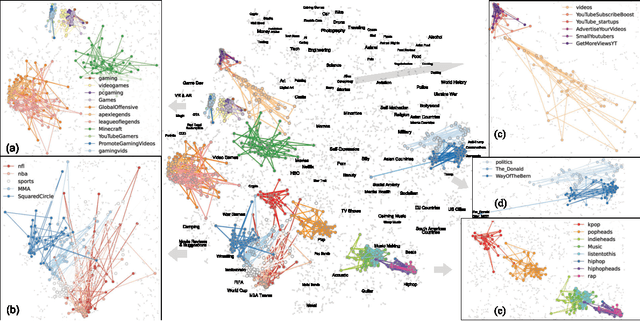
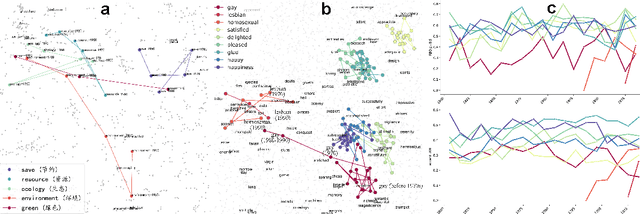

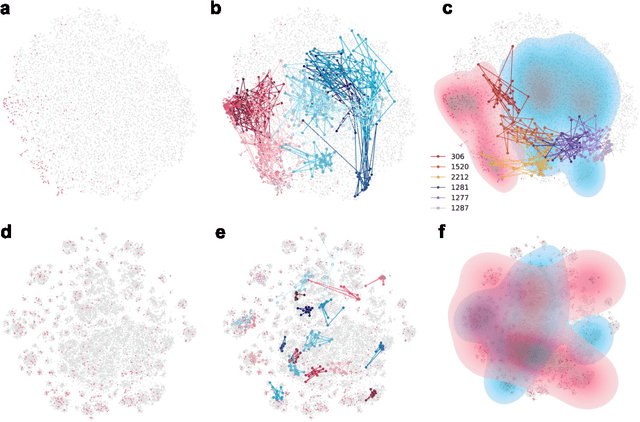
Abstract:We developed DyGETViz, a novel framework for effectively visualizing dynamic graphs (DGs) that are ubiquitous across diverse real-world systems. This framework leverages recent advancements in discrete-time dynamic graph (DTDG) models to adeptly handle the temporal dynamics inherent in dynamic graphs. DyGETViz effectively captures both micro- and macro-level structural shifts within these graphs, offering a robust method for representing complex and massive dynamic graphs. The application of DyGETViz extends to a diverse array of domains, including ethology, epidemiology, finance, genetics, linguistics, communication studies, social studies, and international relations. Through its implementation, DyGETViz has revealed or confirmed various critical insights. These include the diversity of content sharing patterns and the degree of specialization within online communities, the chronological evolution of lexicons across decades, and the distinct trajectories exhibited by aging-related and non-related genes. Importantly, DyGETViz enhances the accessibility of scientific findings to non-domain experts by simplifying the complexities of dynamic graphs. Our framework is released as an open-source Python package for use across diverse disciplines. Our work not only addresses the ongoing challenges in visualizing and analyzing DTDG models but also establishes a foundational framework for future investigations into dynamic graph representation and analysis across various disciplines.
 Add to Chrome
Add to Chrome Add to Firefox
Add to Firefox Add to Edge
Add to Edge